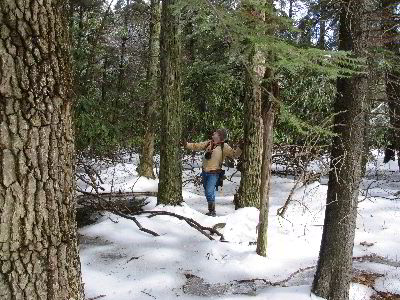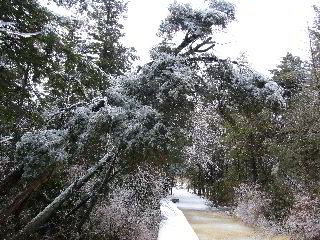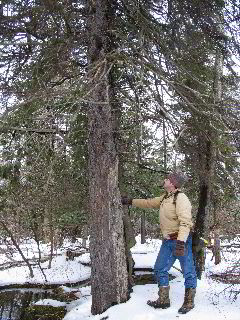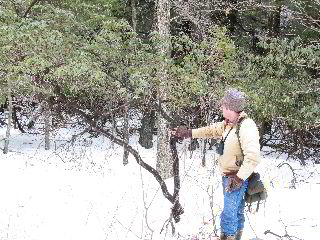ENTS,
On
2/15/08
I had the opportunity to visit
High Point
State Park
, located in the northernmost section of
New Jersey
. I was given a
reliable tip from Bill Sweeney, environmental education specialist
supervisor at
Jacobsburg
Environmental
Education
Center
, about an old growth Atlantic white cedar swamp located there.
High Point
State Park
is named due to it being the highest point in the entire state of
New Jersey
. A large stone
monument marks this point at 1803ft above sea level. The
view from the monument is spectacular.
It was a little brisk and windy that day... the temperature
was in the upper teens, with a sustained wind at that elevation
pushing 35mph with gusts approaching 50, almost blew my camera
tripod over a couple of times, and that was in a sheltered
location...
Here's some background information off their
state park website and pamphlet:
http://www.njparksandforests.org/parks/highpoint.html
"The view from
High Point
Monument
, at 1,803 feet above sea level, is a spectacular panorama of rich
farmland and forest, soft hills and lush valleys in three states.
The blue line of the
Delaware River
divides the verdant ridges of
New Jersey
from those of
Pennsylvania
.
High Point
offers superb trails for hikers and skiers and quiet spots for
campers and anglers.
Located in the extreme
northwest corner of
New Jersey
, the park is situated along the crest of the
Kittatinny
Mountains
in
Sussex
County
. The 15,654-acre
park extends eight miles southwest from the
New York
State
border where it joins
Stokes
State
Forest
. The blue line of
the
Delaware River
divides the verdant ridges of
New Jersey
from those of
Pennsylvania
.
The land for
High Point
State Park
, donated by Colonel Anthony R. and Susie Dryden Kuser, was
dedicated as a park in 1923. The pleasant landscaping was designed
by the Olmsted Brothers of Boston, a prominent landscape
architectural firm of that time. The brothers were the sons of the
eminent Frederick Law Olmsted, who designed
Central Park
.
The monument was built
through the generosity of the Kusers, in honor of all war
veterans. Construction was started in 1928 and completed in 1930.
At the top of the 220-foot structure, observers have a
breathtaking view of the ridges of the
Pocono Mountains
toward the west, the
Catskill Mountains
to the north and the
Wallkill
River
Valley
in the southeast. "

Bill told me that the old
growth Atlantic white cedar swamp was located in the Dryden Kuser
Natural Area. Here's
a brief clip from their website:"
|
Dryden
Kuser Natural Area
(1,500 acres)
|
At 1,500 feet above sea
level, the Atlantic white cedar swamp in Dryden Kuser Natural Area
is the highest elevation swamp of its kind in the world. A
self-guided trail booklet for those who wish to hike the swamp
trail is available at the park office. Endangered species include
the three-tooth cinquefoil and Cooper's hawk.
 View
of cedar swamp
View
of cedar swamp
Virtually untouched by
the logging activities that cleared much of the Kittatinny Ridge
in the 1800's, the cedar swamp supports a variety of conifers,
including large hemlocks, white pine, spruce and mature Atlantic
white cedar. Thickets
of rhododendron, mountain laurel and blueberries interspersed with
shrubs and other plants comprise the undergrowth.
The cedar swamp is also known for its abundant and diverse
population of birds and other wildlife.
The Dryden Kuser Natural
Area includes a distinctive bog, locally called the
Cedar
Swamp
. The Cedar Swamp Trail makes a one and a half mile loop around
the bog. The trail guide described the spring-summer vegetation
and other features of the bog and the surrounding area. The
descriptions in the guide correspond to numbered posts on the
trail. As you enjoy the natural beauty of this area, please
remember to leave it undisturbed for future visitors.
Also, the North Country
Trail runs through the park as well:
To the south, the
Appalachian Trail
follows a rocky ridge which offers many scenic views of the
valleys and mountains surrounding the area. To the north, the
trail drops off the ridge through hemlock gorges into former
agricultural fields with a view of the surrounding countryside and
the
High Point
Monument
in the distance.
" High point Monument
High point Monument
Anyway, Bill directed me to the Kuser Natural
Area to observe the highest known old growth Atlantic white cedar
swamp in the area. I
didn't realize it was the highest known in the world until I read
their website. The
pamphlet says the cedar are "mature", but many of these
are ancient. According
to an interpretive panel on the loop Cedar Swamp Trail, the oldest
cedars starting growing here near 300 years ago.
I easily agree with that statement after observing the
twisted forms of the largest and oldest cedars on my walk that
day.
 HPSP
Atlantic White Cedar Swamp Entrance Area
HPSP
Atlantic White Cedar Swamp Entrance Area
 Atlantic
White Cedar
Atlantic
White Cedar
 Atlantic
White Cedar
Atlantic
White Cedar
Kuser Road
leads you to the Cedar Swamp Trail, but it was closed due to a
good 8-10" of hard pack ice, almost needed my crampons to
walk it. It was a
good mile walk to the trailhead.
Once on the trail, it wasn't long before the swamp came
into view. I decided
to go counterclockwise and immediately ran into my first clump of
cedar. This was the
first time I observed this species of cedar this far away from the
Atlantic coast. The
size of the cedar wouldn't be spectacular to most, but they were
easily the largest I've seen in my limited observation of this
species.
 HPSP
Black Gum
HPSP
Black Gum
Being this high up in elevation just under
the tops of a very windswept mountain, heights and girths of trees
weren't particular impressive.
What did catch my attention was the collection of various
tree species and their associated ages. Pitch
pine was spotty in places along the edges of the swamp which was
dominated by various species of oak (white, chestnut, N. red,
scarlet) and mountain laurel with a scattering of E. white pine.
As you progress into the swamp species composition changed
to being dominated by black gum, E. hemlock, great rhododendron,
and Atlantic white cedar. I
did find one nice (red) spruce in the swamp near the edge.
I didn't venture into the heart of the swamp,
and only stuck to the edge and associated trail on this trip.
The ice was intermittent at spots, and I didn't come
equipped with hip waders (drowners) and hay hooks in case I went
through. As I worked
my way counterclockwise around the swamp,

 The
Boardwalk
The
Boardwalk
I came to a boardwalk that was elevated over
an inundated section of swamp.
This was the best section of trail.
A heavy freezing rain the day before resulted in Atlantic
white cedars hanging over the boardwalk, creating a tunnel like
sensation through the oldest stand of cedars seen so far this day.
This is where the
largest and oldest cedars were located.
Ancient hemlock and black gum interspersed as well, but the
cedars were definitely the "
high point
" of the day. I
was straining to hopefully see some balsam fir tops, but to no
avail. The swamp
brought back memories from another high altitude swamp near
State College
,
PA
known as Bear Meadows N.A, and I was hoping to see more species
similarities:
http://www.nativetreesociety.org/fieldtrips/penna/bear_meadows.htm

Not long after leaving the boardwalk, I noted
a fresh set of black bear tracks crossing the trail and entering
the swamp. That's
funny, I observed no tracks exiting out the other side... I wasn't
alone. The
Cedar
Swamp
was definitely a wild and secluded place this time of year. It
is not difficult to find Kuser Natural Area.
High Point
State Park
is located approximately 4 miles south of Port Jervis, NJ on RT23.
Then follow
Kuser Road
to the trailhead.
http://www.mapquest.com/maps/map.adp?searchtype=address&formtype=search&countryid
=250&addtohistory=&country=US&address=1480+State+Rt+23&city=Sussex&state=NJ&zoom=6
The only bad news of the day was that hemlock
woolly adelgid was here. The
good news was that I didn't observe any major mortality yet.

 (Red)
Spruce
(Red)
Spruce
I noted the following woody species:
Atlantic white cedar
Black gum
Chestnut oak
E. hemlock
E. white pine
Great rhododendron
Juneberry
Mountain laurel
N. red oak
Pitch pine
Red maple
Sassafras
Scarlet oak
White birch
White oak
Yellow birch
 Mountain
Laurel
Mountain
Laurel
Here's a visual age estimate of what I
believe the oldest species located here should attain:
Species
Age Estimate Location
Atlantic white cedar
300+
swamp
Black gum
300
swamp
E. hemlock
300
swamp
(Red) spruce
175
swamp
White oak*
150
swamp edge/upland
N. red oak*
125
swamp edge/upland
Chestnut oak*
100+
swamp edge/upland
Pitch pine*
100
swamp edge/upland
* A pamphlet put out by the park entitled, 'A
High Point in Time: The
Chronological History of High Point State Park', state s that the
ridge the ridgetop was heavily logged
in the 1850's.
Here's a tally of the day's stats:
Species
CBH Height
Comments
Atlantic white cedar
N/A
N/A
~88 rings on boardwalk trail cut limb of 0.9ft
circumference, jutting off main stem of 3ft circumference 7ft up
tree, rings so tight on this limb in certain sections that I
couldn't count them
Atlantic white cedar
6.3
46.9
~300 year age class, most likely even older, largest & gnarliest
observed on hike
Atlantic white cedar
N/A
54.5
unreachable due to ice and high water
Atlantic white cedar
5
N/A
~300 year age class
Atlantic white cedar
5.4
56.3
~300 year age class
Atlantic white cedar
4.1
56.6
Atlantic white cedar
4.4
N/A
41 19.775N x 74 39.501W
Black gum
7.4
42.6
huge bark furrows (~4" deep!), ~300+ age class
(Red) spruce
4.8
60
~175+ age class, similar in size, site, bark texture, &
crown architecture to those cored at Bear Meadows N.A.
E. hemlock
8.7
70.6
E. white pine
7.8
88.1
Great rhododendron
1
N/A
Mountain laurel
0.7
11.4
Pitch pine
3.9
50.6
Pitch pine
5.4
70
White birch
N/A
N/A
~36 rings at 3.4ft up at 1ft circumference
Sorry, guys, one species shy of a Rucker
Index. The oaks were
located just outside the swamp, and I wanted to spend my limited
time exploring the old growth within the swamp.
Another great day, and a must see site for ENTS who happen
to be passing through the area.
Dale